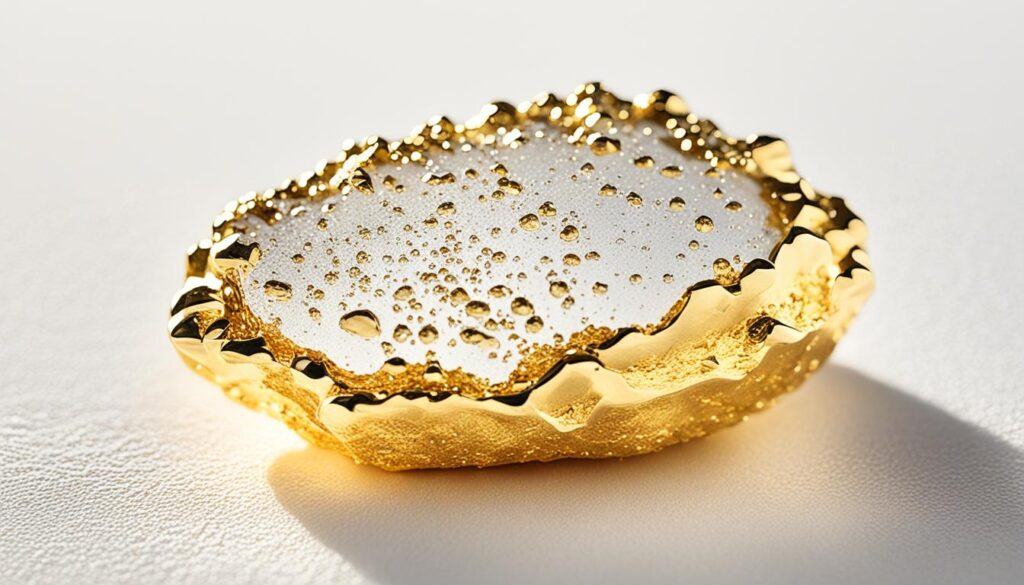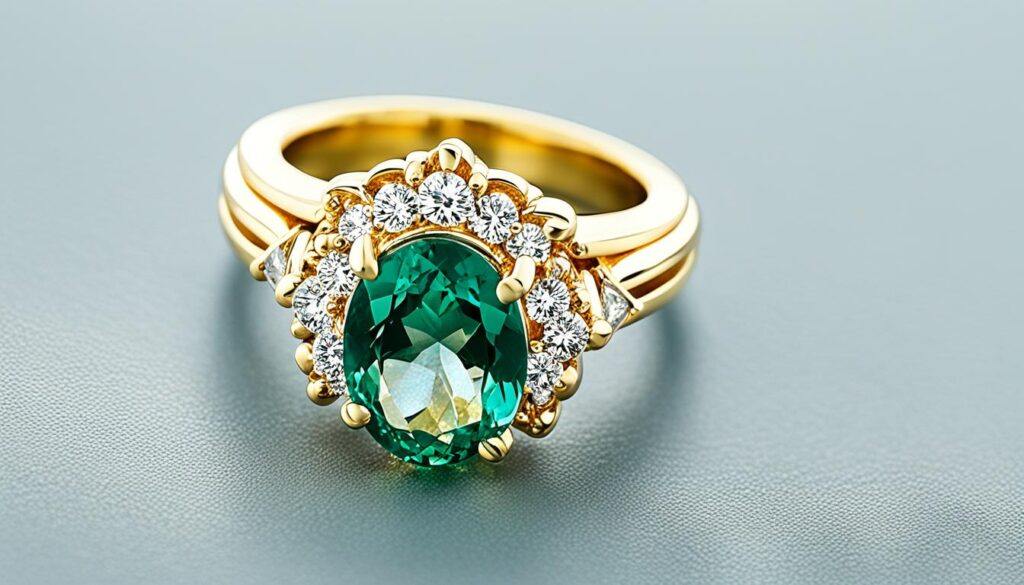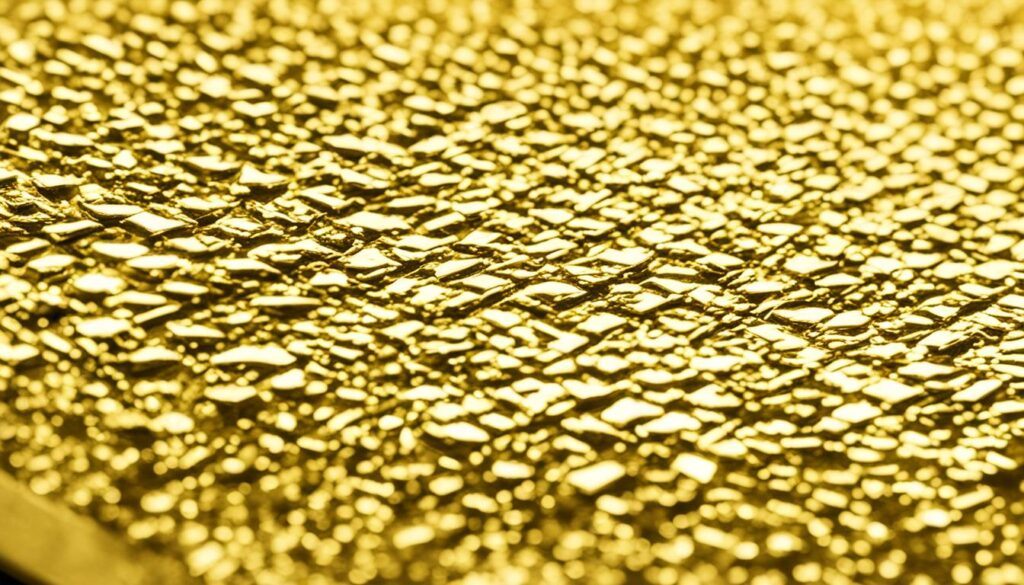Did you know that 24 karat gold is the purest form of gold, consisting of 99.9% gold with no other metals added? This level of purity gives it a unique softness that distinguishes it from other karat levels of gold. The softness of 24 karat gold stems from its atomic structure, which allows it to be easily shaped and molded.
While the softness of 24 karat gold adds to its allure, it also has implications for its durability, especially when used in jewelry. In this article, we will explore the softness of 24 karat gold in more detail and its impact on its suitability for different types of jewelry.
Key Takeaways:
- 24 karat gold is the purest form of gold, composed of 99.9% gold with no additional metals added.
- Its high purity makes 24 karat gold soft and easily malleable.
- The softness of 24 karat gold affects its durability and makes it more prone to bending and scratching.
- While it may not be ideal for everyday jewelry, 24 karat gold is valued for other applications such as gilding and electronics.
- When choosing gold for jewelry, factors such as the type of jewelry, budget, and aesthetic preferences should be considered.
The Durability of 24 Karat Gold
When it comes to gold, the softness level of 24 karat gold is an important factor to consider. Due to its high purity, 24 karat gold is known for its soft and malleable characteristics. However, this softness also affects its durability compared to other karat levels of gold.
Unlike lower karat levels that are alloyed with other metals to enhance their strength, pure 24 karat gold is more prone to bending, scratching, and losing its structural integrity over time. This makes it less suitable for jewelry that is meant to endure daily wear and tear, such as engagement or wedding rings.
It’s important to note that the hardness of 24 karat gold can vary slightly depending on the specific alloy used. While it may be slightly harder than pure gold, it still remains significantly softer compared to lower karat gold alloys.
Therefore, if you’re considering purchasing jewelry for everyday use, opting for a lower karat level, such as 18 karat or 14 karat gold, would be a more practical choice. These alloys provide a better balance of durability and beauty.
However, if you’re looking for jewelry that is only worn on special occasions or for collecting wealth, the softness of 24 karat gold may not be a major concern. In such cases, the unique characteristics and beauty of pure gold outweigh the potential need for more frequent maintenance and care.
It’s worth highlighting that even though 24 karat gold is softer, it remains highly valuable due to its high gold content. Its softness allows for intricate and detailed designs, making it a popular choice for fine jewelry pieces that require delicate craftsmanship.
Regardless of the karat level you choose, proper care and maintenance are essential to ensure the longevity of your gold jewelry. Regular cleaning and storing your jewelry in a safe place when not in use will help prevent damage and maintain its beauty for years to come.

Characteristics of 24 Karat Gold:
- Soft and malleable
- Purest form of gold
- Prone to bending and scratching
- Requires more frequent maintenance
- Ideal for intricate and detailed designs
- Highly valuable due to its high gold content
“The softness of 24 karat gold allows for intricate and detailed designs, making it a popular choice for fine jewelry pieces that require delicate craftsmanship.”
Differences in Karat Levels of Gold
Gold is measured in karats, with higher karat numbers representing a higher percentage of pure gold. The karat level of gold determines its composition and overall properties, including durability and appearance.
10 Karat Gold
10 karat gold is the lowest solid gold alloy used for jewelry. It contains 41.7% gold and 58.3% alloy. The alloy component is often made up of metals like copper and silver, which are added to increase the durability and hardness of the gold. However, the lower gold content can result in a slightly less vibrant color compared to higher karat levels.
14 Karat Gold
14 karat gold is the most commonly used gold for jewelry settings. It consists of 58.3% gold and 41.7% alloy. The higher gold content gives it a richer color and a balance between durability and purity. 14 karat gold is often preferred for engagement rings, wedding bands, and other pieces of jewelry that are worn frequently.
18 Karat Gold
18 karat gold is less commonly used due to its higher cost. It contains 75% gold and 25% alloy. The higher gold content results in a deeper yellow color and a higher level of purity. 18 karat gold is often used for high-end jewelry pieces and is prized for its richness and value.
“Each karat level of gold has its own unique properties and characteristics that affect its durability and appearance.”
When choosing gold jewelry, it’s important to consider the karat level that suits your preferences and budget. Higher karat gold may be more expensive, but it offers a higher percentage of pure gold and a richer color. Lower karat gold, on the other hand, may provide better durability and is often more affordable.

Understanding the differences in karat levels of gold can help you make an informed decision when selecting the perfect piece of jewelry. Whether you’re looking for a delicate necklace, a stunning ring, or a timeless bracelet, the karat level of gold will play a significant role in the overall quality and appearance of the piece.
Common Uses of 24 Karat Gold
While 24 karat gold is not commonly used for everyday jewelry, it finds its application in several other industries due to its unique properties. The malleability and ductility of 24 karat gold make it highly desirable for various purposes.
One of the common uses of 24 karat gold is in decorative gilding processes, such as gold leafing and plating. The softness of 24 karat gold allows artisans to shape and mold it effortlessly, creating intricate designs and embellishments. This makes it a popular choice for adding a touch of luxury to art pieces, furniture, and even architectural elements.
In addition to decorative applications, 24 karat gold is also extensively used in the production of electronic and medical devices. The exceptional conductivity of gold makes it ideal for circuits and connectors, ensuring smooth transmission of electrical signals. Moreover, the biocompatibility of 24 karat gold makes it suitable for medical implants and devices, reducing the risk of allergies or adverse reactions.
Furthermore, 24 karat gold plays a significant role in the production of investment products such as coins and bars. Investors value the purity and rarity of 24 karat gold, considering it a tangible asset that can preserve and grow their wealth.
Let’s take a closer look at the common uses of 24 karat gold:
| Common Uses of 24 Karat Gold |
|---|
| Decorative gilding processes |
| Electronic and medical devices |
| Coins and bars for investment |

Factors to Consider When Choosing Gold for Jewelry
When it comes to selecting the right type of gold for your jewelry, several factors should be taken into consideration. This includes the type of jewelry, your budget, and your aesthetic preferences.
The type of jewelry and its intended use will determine the durability requirements and the karat level of gold that is most suitable. For example, engagement rings and wedding bands are typically worn daily and subjected to constant wear and tear. Therefore, a lower karat level, such as 14k or 18k, may be a more practical choice due to their added durability. On the other hand, if you’re purchasing jewelry for special occasions or as a collector’s item, a higher karat level, such as 24k, may be preferred for its pure gold content.
Your budget is an important consideration as well. Higher karat levels of gold, such as 18k and 24k, tend to be more expensive due to their higher gold content. If you have a limited budget, you may need to opt for a lower karat level or consider alternative metals like silver or platinum.
Aesthetic preferences also play a significant role in the decision-making process. Some individuals prefer the rich, intense color of higher karat gold, while others prefer the subtler hue of lower karat gold. Additionally, certain jewelry designs may look better with a specific karat level, depending on the desired aesthetic and style.
Taking all these factors into account will help you make an informed decision when choosing the right type of gold for your jewelry.
| Factors | Considerations |
|---|---|
| Type of Jewelry | – Daily wear: consider lower karat levels for added durability – Special occasions/collectible: higher karat levels for pure gold content |
| Budget | – Higher karat levels tend to be more expensive – Consider alternative metals if budget is a constraint |
| Aesthetic Preferences | – Intensity of gold color – Suitability of karat level for desired style and design |
How to Determine the Purity of Gold
When it comes to assessing the purity of gold, there are a few methods you can utilize. If you want the most accurate results, it is advisable to seek the assistance of a reputable jeweler who can conduct a professional gold purity test. They have the expertise and equipment to perform precise assessments. The process usually involves scratching the gold on a specialized testing pad and observing its reaction with a specific acid. This test allows for a reliable determination of the gold’s purity.
If you prefer to perform a simple test at home, you can use vinegar, a common household ingredient. Begin by applying a few drops of vinegar to the gold item you wish to test. Take note of any changes in color or appearance. If the gold remains unchanged, it is likely to be pure 24 karat gold. However, it is important to remember that this method may not be as accurate or reliable as professional testing.
Professional Gold Purity Testing
A reputable jeweler will have access to professional gold purity testing methods that provide accurate results. These methods include:
- Acid Testing: This involves applying specific acids to the gold item and examining the reaction to determine its purity.
- X-Ray Fluorescence (XRF) Analysis: This non-destructive testing method uses X-rays to analyze the composition of the gold.
- Spectrometry Testing: This technique utilizes spectrometers to measure the wavelengths of light emitted by the gold and determine its purity.
At-Home Vinegar Test
The at-home vinegar test is a simple and cost-effective method to get a rough idea of the gold’s purity. However, keep in mind that the results may not be as accurate as professional testing. To perform the test, follow these steps:
- Place the gold item on a clean surface.
- Apply a few drops of vinegar to the gold.
- Observe any changes in color or appearance.
- If the gold remains the same color, it is likely pure 24 karat gold.
Remember, if you want a definitive assessment of your gold’s purity, it is best to consult a professional. They have the knowledge and resources to provide you with accurate results.
| Testing Method | Accuracy | Cost |
|---|---|---|
| Professional Gold Purity Test | High | Varies (typically incurs a fee) |
| Vinegar Test | Low to Moderate | Minimal (uses household vinegar) |
Advantages of Investing in Gold
Investing in gold is often considered a wise financial decision. Gold has long been recognized as a safe and reliable investment option due to its unique properties and enduring value. Here are some of the key advantages of investing in gold:
- Hedge against currency fluctuations: Gold can act as a hedge against currency fluctuations and economic uncertainties. As a tangible asset, gold retains its value even during times of financial instability, making it a reliable store of wealth.
- Inflation protection: Gold has historically proven to be an effective hedge against inflation. During periods of rising prices and eroding purchasing power, the value of gold tends to increase, helping to preserve the wealth of investors.
- Diversification: Including gold in an investment portfolio can help diversify risk. Gold often has a low correlation with other asset classes, such as stocks and bonds, meaning that it can perform differently under various market conditions. This diversification can help reduce overall portfolio volatility.
- Long-term value appreciation: Historically, the value of gold has tended to increase over the long term. While short-term fluctuations are inevitable, gold has consistently demonstrated its ability to preserve and increase its value over time.
“Gold is the ultimate asset bubble insurance.”
It is important to note that investing in gold, like any other investment, involves risks and should be done with careful consideration. Market factors, such as supply and demand dynamics and geopolitical influences, can impact the price of gold. Consulting with a qualified financial advisor or conducting thorough research can help investors make informed decisions about including gold in their investment strategies.
Conclusion
In conclusion, 24 karat gold is indeed soft due to its high purity. This softness makes it less suitable for everyday jewelry that requires durability. However, it has unique properties and is valued for its malleability and ductility, making it suitable for other applications such as gilding and electronics.
When choosing gold for jewelry, it is important to consider factors such as the type of jewelry, budget, and desired aesthetic. While 24 karat gold may not be ideal for all jewelry pieces, it can be a good option for special occasion pieces or collectors who appreciate its softness and purity.
Additionally, investing in gold can be a solid financial decision, particularly as a long-term investment. Gold has historically held its value and can serve as a hedge against economic uncertainty. However, it is important to conduct careful research and seek professional advice before making any investment decisions.
FAQ
Is 24 karat gold soft?
Yes, 24 karat gold is soft due to its high purity. It is the purest form of gold, with a composition of 99.9% gold and no other metals added.
What is the softness level of 24 karat gold?
The softness of 24 karat gold is a result of its atomic structure, which allows the metal to be malleable and easily shaped.
How does the softness of 24 karat gold affect its durability?
The softness of 24 karat gold makes it more prone to bending, scratching, and losing its structural integrity over time compared to other karat levels of gold.
What are the characteristics of 24 karat gold?
24 karat gold is known for its softness, high purity, and rich, intense gold color.
What are the different karat levels of gold?
Gold is measured in karats. 10 karat gold is the lowest solid gold alloy used for jewelry, followed by 14 karat gold and 18 karat gold.
Why is 24 karat gold not commonly used for everyday jewelry?
The softness of 24 karat gold makes it less suitable for jewelry that is meant to be worn daily, as it is more prone to damage and requires more frequent maintenance.
What are the common uses of 24 karat gold?
24 karat gold is often used for decorative gilding processes, electronic or medical devices, and the production of coins and bars for investment purposes.
What factors should be considered when choosing gold for jewelry?
When choosing gold for jewelry, factors such as the type of jewelry, budget, and desired aesthetic should be taken into consideration.
How can the purity of gold be determined?
The purity of gold can be determined by consulting a reputable jeweler who can perform a professional gold purity test. An at-home test using vinegar can also provide an indication of purity, but professional testing is more accurate.
What are the advantages of investing in gold?
Gold is often considered a safe and reliable investment due to its scarcity, inherent value, and tendency to increase in value over time. It can help diversify investment portfolios and protect against currency fluctuations and inflation.



